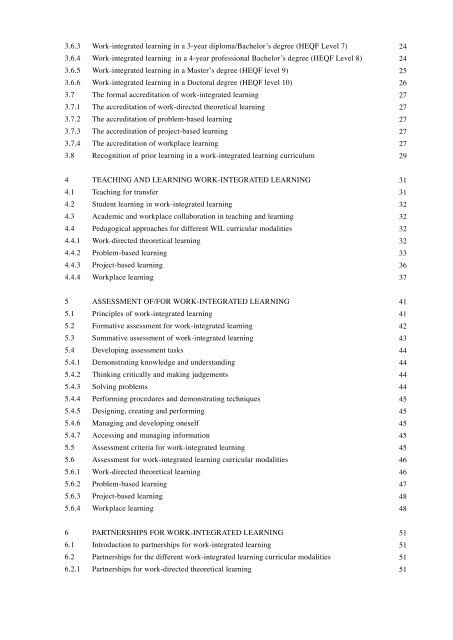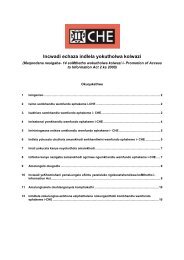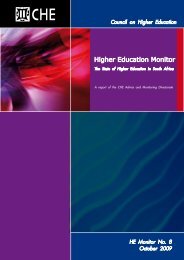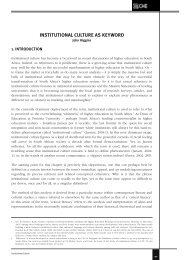Work-Integrated Learning: Good Practice Guide - CHE
Work-Integrated Learning: Good Practice Guide - CHE
Work-Integrated Learning: Good Practice Guide - CHE
Create successful ePaper yourself
Turn your PDF publications into a flip-book with our unique Google optimized e-Paper software.
3.6.3 <strong>Work</strong>-integrated learning in a 3-year diploma/Bachelor’s degree (HEQF Level 7)<br />
3.6.4 <strong>Work</strong>-integrated learning in a 4-year professional Bachelor’s degree (HEQF Level 8)<br />
3.6.5 <strong>Work</strong>-integrated learning in a Master’s degree (HEQF level 9)<br />
3.6.6 <strong>Work</strong>-integrated learning in a doctoral degree (HEQF level 10)<br />
3.7 the formal accreditation of work-integrated learning<br />
3.7.1 the accreditation of work-directed theoretical learning<br />
3.7.2 the accreditation of problem-based learning<br />
3.7.3 the accreditation of project-based learning<br />
3.7.4 the accreditation of workplace learning<br />
3.8 recognition of prior learning in a work-integrated learning curriculum<br />
4 tEAcHINg ANd LEArNINg <strong>Work</strong>-INtEgrAtEd LEArNINg<br />
4.1 teaching for transfer<br />
4.2 Student learning in work-integrated learning<br />
4.3 Academic and workplace collaboration in teaching and learning<br />
4.4 Pedagogical approaches for different WIL curricular modalities<br />
4.4.1 <strong>Work</strong>-directed theoretical learning<br />
4.4.2 Problem-based learning<br />
4.4.3 Project-based learning<br />
4.4.4 <strong>Work</strong>place learning<br />
5 ASSESSMENt oF/For <strong>Work</strong>-INtEgrAtEd LEArNINg<br />
5.1 Principles of work-integrated learning<br />
5.2 Formative assessment for work-integrated learning<br />
5.3 Summative assessment of work-integrated learning<br />
5.4 developing assessment tasks<br />
5.4.1 demonstrating knowledge and understanding<br />
5.4.2 thinking critically and making judgements<br />
5.4.3 Solving problems<br />
5.4.4 Performing procedures and demonstrating techniques<br />
5.4.5 designing, creating and performing<br />
5.4.6 Managing and developing oneself<br />
5.4.7 Accessing and managing information<br />
5.5 Assessment criteria for work-integrated learning<br />
5.6 Assessment for work-integrated learning curricular modalities<br />
5.6.1 <strong>Work</strong>-directed theoretical learning<br />
5.6.2 Problem-based learning<br />
5.6.3 Project-based learning<br />
5.6.4 <strong>Work</strong>place learning<br />
6 PArtNErSHIPS For <strong>Work</strong>-INtEgrAtEd LEArNINg<br />
6.1 Introduction to partnerships for work-integrated learning<br />
6.2 Partnerships for the different work-integrated learning curricular modalities<br />
6.2.1 Partnerships for work-directed theoretical learning<br />
24<br />
24<br />
25<br />
26<br />
27<br />
27<br />
27<br />
27<br />
27<br />
29<br />
31<br />
31<br />
32<br />
32<br />
32<br />
32<br />
33<br />
36<br />
37<br />
41<br />
41<br />
42<br />
43<br />
44<br />
44<br />
44<br />
44<br />
45<br />
45<br />
45<br />
45<br />
45<br />
46<br />
46<br />
47<br />
48<br />
48<br />
51<br />
51<br />
51<br />
51






